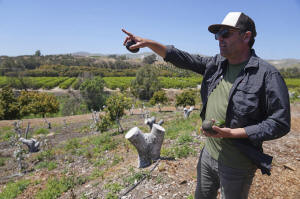California avocado growers say Mexican imports have helped their sales
[May 29, 2025] By
AMY TAXIN
SOMIS, Calif. (AP) — Andreas Tompros lost his home and at least a third
of his avocado orchard to a wildfire last year, but the 47-year-old
grower is not worried about his farm making a comeback.
While California farmers often rattle off a list of challenges they face
including high labor costs, water restrictions and overseas competition,
many avocado growers say they have a good thing going. A key reason may
come as a surprise to some — Mexican imports.
When the United States lifted its ban on Mexican avocados in 1997,
California growers worried at first that the imported fruit would
displace their production.
But the steady flow of avocados has wound up helping, not hurting, their
sales by allowing for a year-round supply to markets and restaurants
that has fomented demand, farmers say. Before the influx, most American
consumers considered avocados to be specialty items — and when they came
into season in California, industry officials had to work to rev up
widespread interest in order to sell them.
But not anymore.
Avocado consumption has been booming in the United States over the past
two decades. The amount of fruit available per person tripled to more
than 8 pounds (3.6 kilograms) between 2000 and 2021, federal statistics
show. Avocado toast and guacamole are regular offerings not just in
culinary hubs like NYC but at cafes around the Midwest and the South.

Avocados are in demand
On a steep, sun-soaked hillside northwest of Los Angeles, Tompros is
replanting nearly 300 avocado trees with the belief that Americans’
hunger for the fruit — and his orchard — will continue to grow.
“It will come back, and I believe it will become better than it was,”
Tompros, who previously ran a software company in Hollywood, said of the
orchard he took over five years ago in the tiny community of Somis.
Avocado demand has also been buoyed by consumers' growing interest in
healthy fats, said Emiliano Escobedo, executive director of the Hass
Avocado Board.
A 2000 U.S. law created the board that collected 2.5 cents for every
pound (0.5 kilograms) of avocados imported or produced in the United
States. The board used the money to market avocados and conduct
nutritional research, an effort that has been widely credited with
making the fruit ubiquitous in supermarkets and on restaurant menus.
“It’s been really wildly successful. It generates way more money than
most of these other industry boards do,” said Richard Sexton,
distinguished professor of agricultural and resource economics at the
University of California, Davis. “When you look at the growth rate in
avocado consumption relative to all fruits, the difference in growth
rate is dramatic.”
A successful crop
Escobedo said about 60% of U.S. households currently buy avocados, and
about half of these are responsible for the overwhelming majority of
consumption, which means there’s still room for the market to grow —
especially in the Northeast, where the fruit is less common.
“There is a lot of opportunity for certain groups of people to increase
their purchasing of avocados,” Escobedo said.
[to top of second column] |

Andreas Tompros tours his avocado farm, Ridgecrest Avocados, on
Thursday, May 15, 2025. (AP Photo/Damian Dovarganes)
 While the Trump administration has
threatened tariffs on a spate of Mexican goods, avocados have so far
been spared. California growers said they want Mexican avocados to
keep flowing into the country, though they also want robust U.S.
inspections of the imports to keep out pests to protect their crop.
“If you are going to farm in California, avocados are about the best
deal right now,” said Ken Melban, president of the California
Avocado Commission.
California farmers grow about 10% of the avocados eaten in the
United States, Melban said, and account for nearly all of the
country’s domestic avocado production. The fruit is largely grown in
California from April through September, and Mexican imports arrive
year-round to meet nationwide demand, which exceeds what the state's
farmers grow, he said.
In Southern California's Ventura County, many growers have shifted
to avocados since lemon prices were walloped by cheaper imports from
Argentina. As recently planted trees start bearing fruit in a few
years, the region's avocado production is likely to rise, said
Korinne Bell, agricultural commissioner for the county northwest of
Los Angeles.
A booming market, despite wildfires
Avocado trees do not come without risks in a region prone to
wildfires.
Still, demand for the trees has jumped due to interest from lemon
growers — and since the November 2024 fire charred Ventura County
avocado orchards, said Rob Brokaw, whose family-owned nursery has
supplied avocado trees to California growers for 70 years.
“Right now we are sold out essentially for this year,” Brokaw said.
“And we're mostly sold out for 2026.”
Tompros debated whether to plant the more fire-resistant lemon trees
or another crop after the fire ripped through Somis, but he decided
to replant due to the soaring demand for Super Bowl guacamole and
avocado toast.

“It’s the super food, and it’s still growing in popularity,” Tompros
said.
He’s taking precautions to not plant the trees too close to what
will eventually be his rebuilt home, because the dried-out leaves
that help nourish the orchard's soil can also fuel blazes.
It may take a few years, but Tompros hopes it won’t be too long
before his newly planted trees bear fruit that he can sell to a
local packinghouse or in seasonal gift boxes with citrus and
passionfruit that he ships directly to customers.
All contents © copyright 2025 Associated Press. All rights reserved |